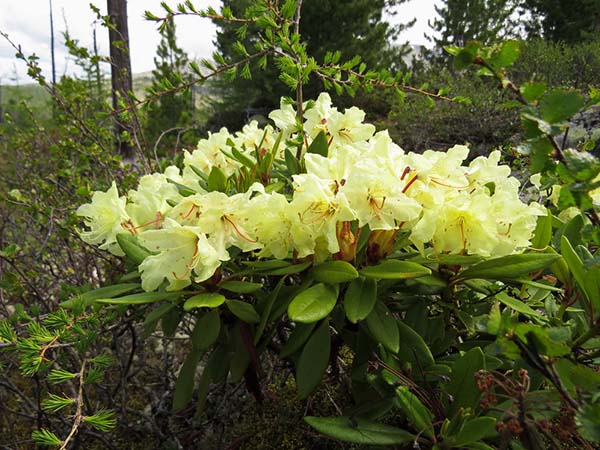Ornamental trees and shrubs with yellow flowers and foliage: names, brief descriptions and illustrations
The design of a personal plot almost always implies planting flowers, trees and small shrubs, which will not only become an ornament, but can also yield berries and fruits. But quite often, landscape design involves planting plants to create exclusive expositions of ornamental trees and shrubs that will stand out in the general plan of green spaces.
An example would be trees and shrubs with yellow leaves and flowers.
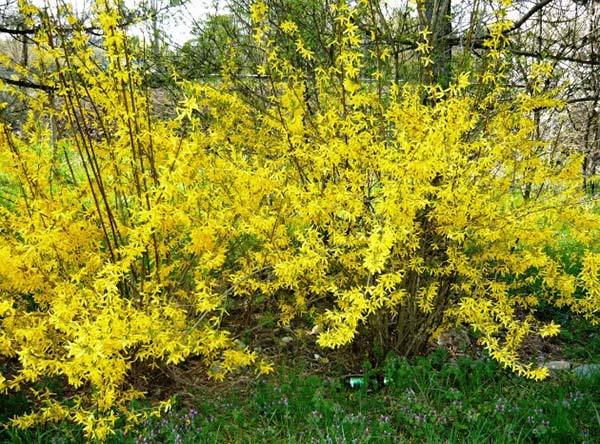
Content
Trees with yellow leaves
It has long been considered that trees are green crowns. But in nature there are plants with red foliageas well as with yellow leaves. These ornamental plants will make the landscape composition on the personal plot not only diverse, but also quite original.
The most prominent representatives of yellow-leaved trees are the following:
Gleditsia three-pricklyvarieties "Sunburst"
It is a very fast growing tree that can reach up to 12 meters in height and 10 meters in width (after 20-30 years).
Important! The tree of the presented yellow-leaved variety "Sunburst" does not bear fruit, which means that you will not have problems with harvesting beans that pollute the area.
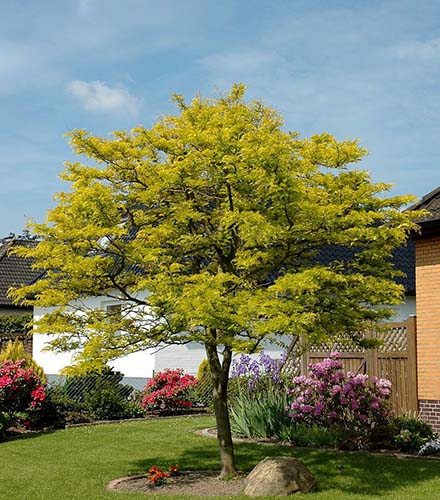
In spring, the young foliage is golden in color, in summer it turns pale green, and in autumn it again takes on a yellow tint.
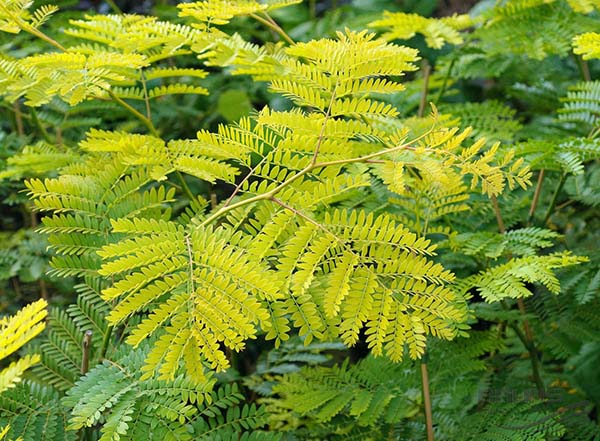
It is quite unpretentious in care, except that a drained soil is required, while the plant is drought-resistant. Has a high frost resistance up to -34 ..- 40 degrees.
By the way! Propagated by vegetative methods: cuttings and grafting into the root collar.
Catalpa bignoniform varieties "Aurea"
Distinctive features of this deciduous tree are its broad-oval heart-shaped leaves, similar to lilac leaves. After blooming, the leaves have a bright golden color, in summer they are lemon yellow (light green), by autumn they acquire a yellow color.
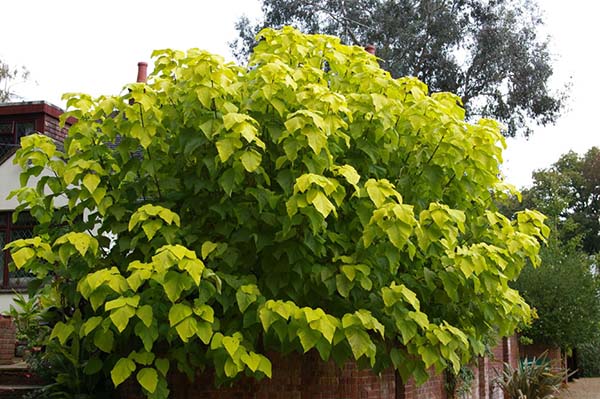
Blossoms with fragrant white panicles-flowers in June-July. Then rather decorative long beans appear.
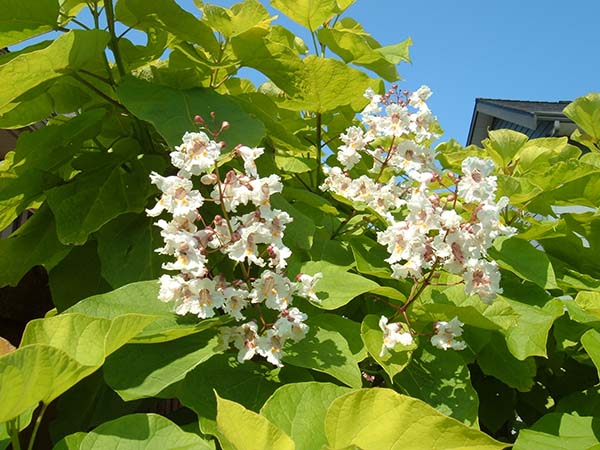
Looks most impressive in single landings. In height it can reach 8-10 meters, width - 5-8 meters.
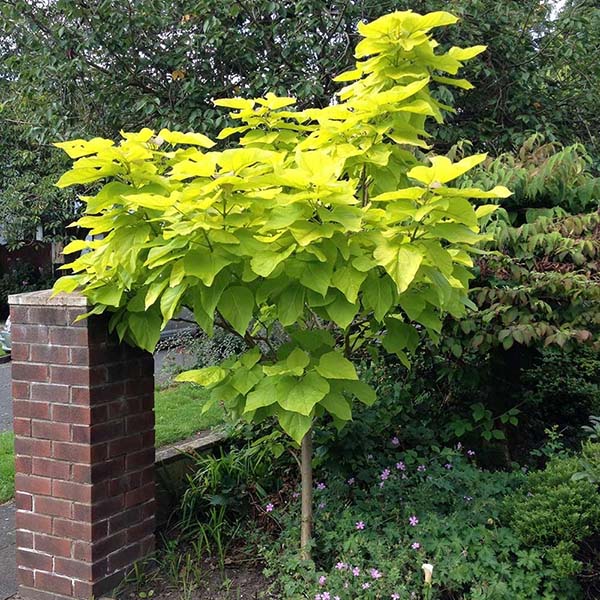
Growing conditions:
- A place protected from the winds is required.
- Fertile and well-drained soil, but can also grow on heavy clay soils.
- Drought tolerant.
- Hardy enough (up to -25 ..- 30 degrees).
By the way! Propagated vegetatively: semi-lignified cuttings and grafting.
Ash-leaved maple varieties "Odessanum" and "Kelly Gold"
In heightash-leaved maple "Odessa" can reach 7-10 m, in width - 5-7 m. Leaves when blooming are bronze, then it becomes a yellow-golden hue. Blooms in March-April, but not bright: pale yellow small flowers.
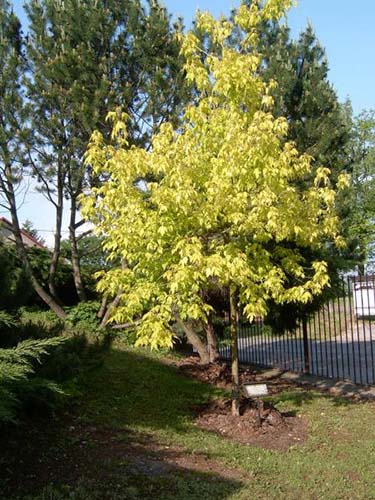
As for Kelly Gold, this tree can be up to 8 m high, up to 3.5-5 m wide. The color of the leaves is from golden to lime green, with reddish petioles. In autumn they take on a bright yellow hue.
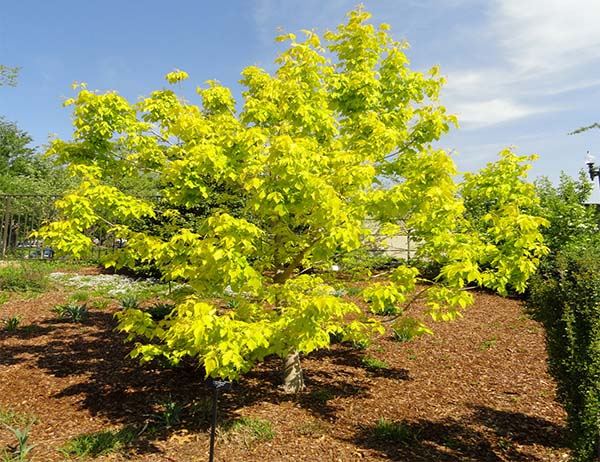
Growing conditions:
- It can grow on any kind of soil, preferably with neutral acidity.
- It is desirable that the place is protected from the wind.
- Hardy enough.
Liriodendron tulip (Tulip tree)
The main original feature of this tree is its flowers. They are very similar in shape to tulips, have gray-yellow or yellow-green petals, and an orange spot stands out in the middle at the base of the apical leaves.
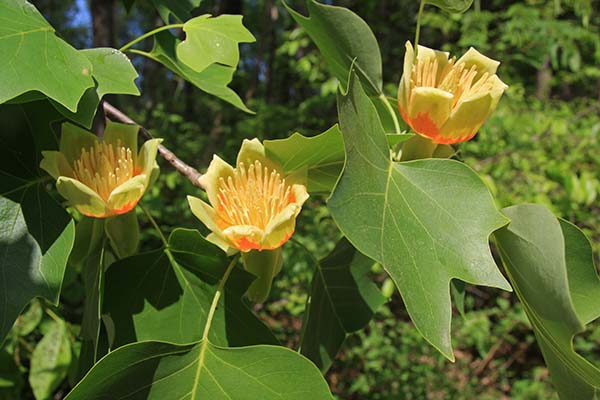
In addition, the tulip tree in autumn paints the leaves with a golden yellow hue, thereby continuing to delight with its extraordinary beauty after flowering.
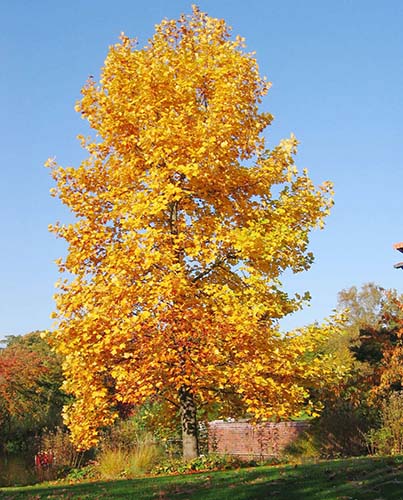
Worth knowing! Trees and shrubs with yellow foliage must certainly be planted in sunny areas, since even partial shade can cause the yellow color of the leaves to turn green. However, light shading is allowed (very light partial shade).
Shrubs with yellow leaves and flowers
Shrubs are also noted for originality, which have not only yellow foliage, but sometimes the flowers themselves.
Among such yellow-leaved shrubs, the following can be noted:
Barberry Thunberg
Barberry Thunberg is one of the most popular plants that is planted to decorate summer cottages. Its flowering period is between April and June.Bright yellow flowers are fragrant with a pleasant aroma, thereby attracting honey workers. As for the foliage, in spring it is yellow, in summer it turns green, and by autumn it becomes golden again.
In addition, this plant has edible red fruits that have a sour taste, and at the same time are medicinal.
As for the requirements for cultivation, the shrub prefers drained soils, which means that it cannot be overmoistened - moisture stagnation should be allowed. Better to let it dry once again! And this decorative barberry is very frost-hardy - up to -35 ... -40, depending on the variety.
Among the yellow-leaved barberries, the following varieties can be distinguished:
- Aurea (Aurea);
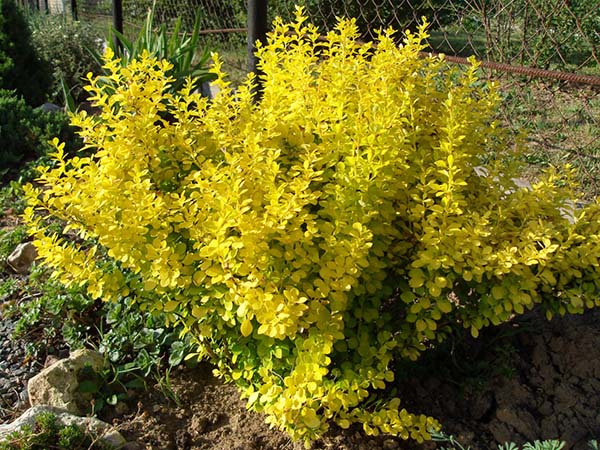
- Maria (Maria);
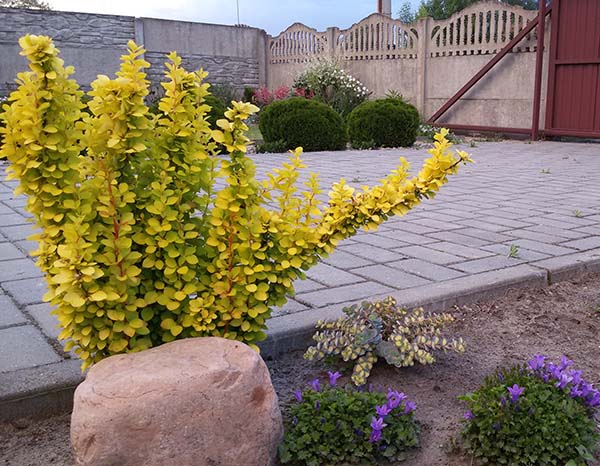
- Diabolicum;
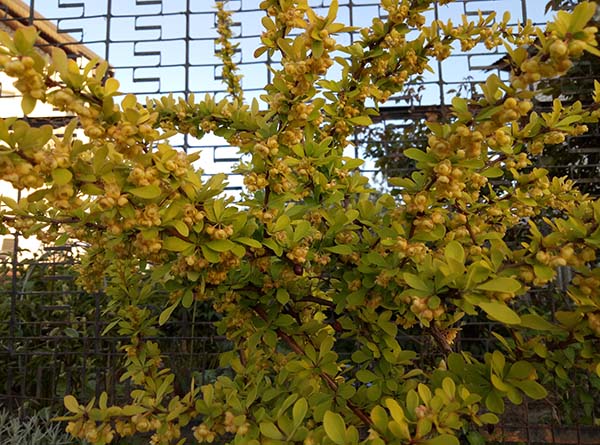
- Bonanza Gold;
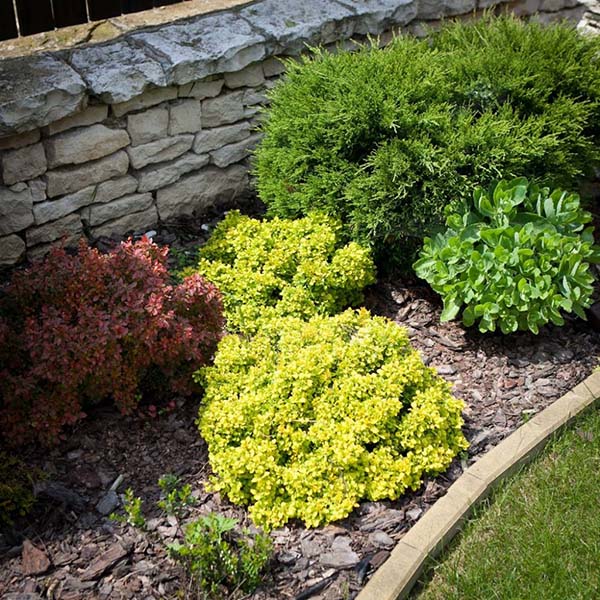
- Golden Rocket;
- Bonanza Monlers;
- Tiny Gold.
By the way! You can propagate yellow and any other Thunberg barberry by rooting semi-lignified cuttings.
Euonymus
The most popular yellow varieties are:
- Fortune euonymus Emerald Gold.
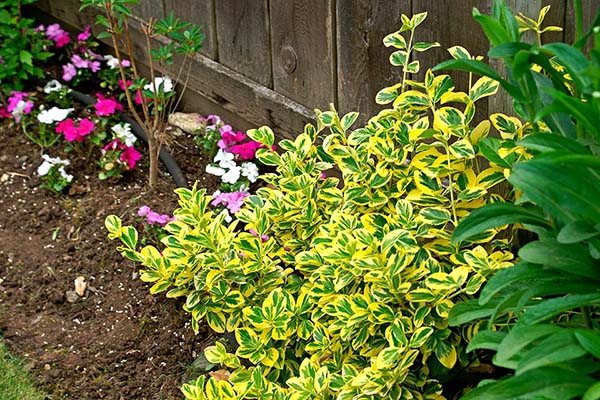
It is a creeping shrub up to 1 meter high. The color of the leaves of the plant is emerald-lemon. In spring, it blooms with small white-green flowers.
By the way! It will look very nice in stone gardens and flower beds.
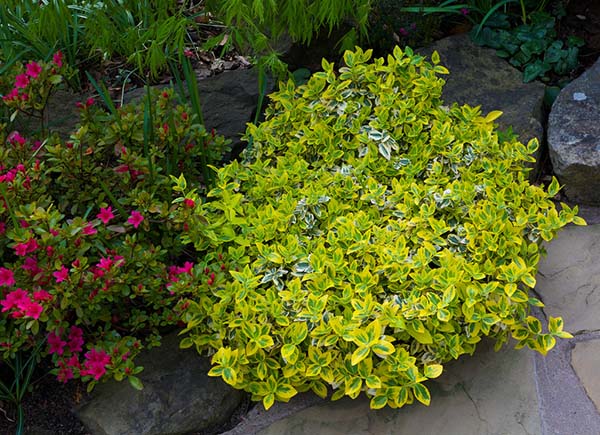
- Fortune Sunspot's euonymus.
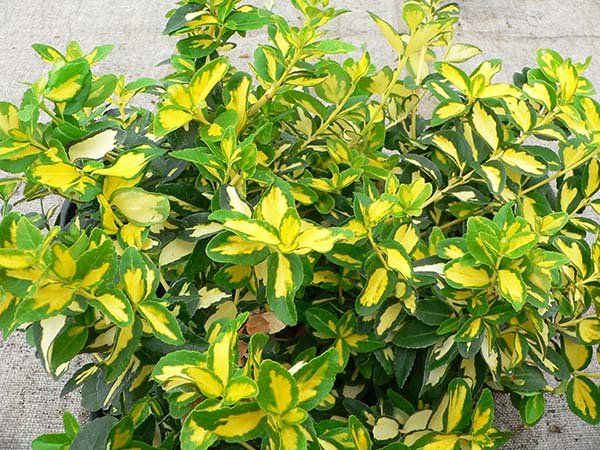
Growing features:
- well-drained soil is required.
- quite frost-resistant (up to -25 degrees), but it is better to cover for the winter.
Elderberry Canadian (black) variety "Aurea"
This shrub grows up to 3-4 meters in height and has an extensive crown. One of the main features is that this bush blooms with white round inflorescences (in the form of scutes), and the leaves with pointed ends are yellow.
Elderberry blooms from early July to late August.
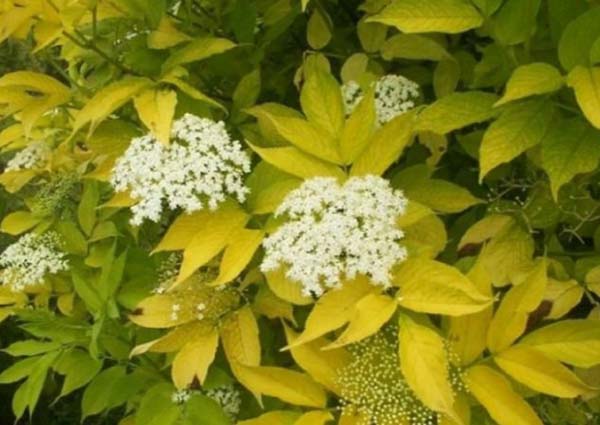
In addition, the elderberry produces fruits that are edible.
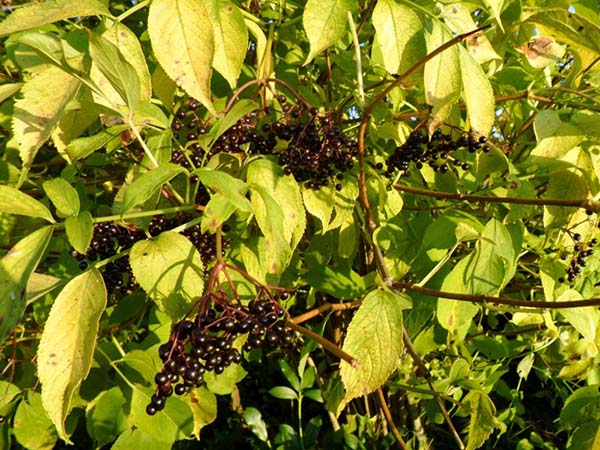
Among the main features of elderberry care should be noted:
- it is thermophilic enough, but can overwinter in areas with short, but rather severe frosts (but not more than -15 ... -20 degrees);
- not demanding on fertility, prefers alkaline soils, although it can grow on acidic;
- loves relatively moist, which means well-drained soil. However, it can grow on moderately dry soils;
- can be grown both in single and group plantings (hedges).
- propagates vegetatively - semi-lignified cuttings.
Important! Starts to grow back well after cutting.
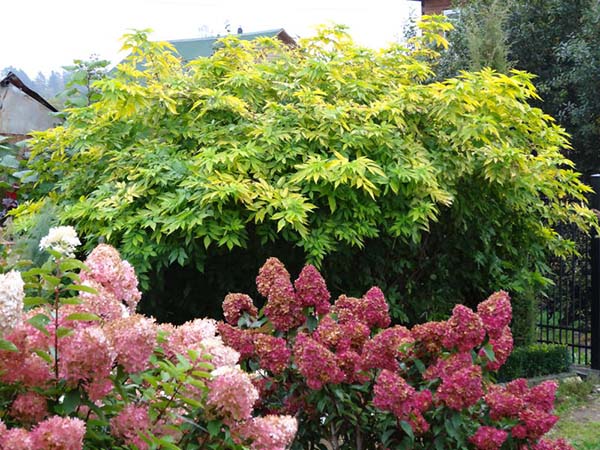
Kalina gordovina variety "Aureum"
This deciduous shrub can grow up to 2.5 meters in height and width, but grows rather slowly.
It has leathery, rounded ovoid leaves that have a yellow tint when blooming, but then (in summer) turn green.
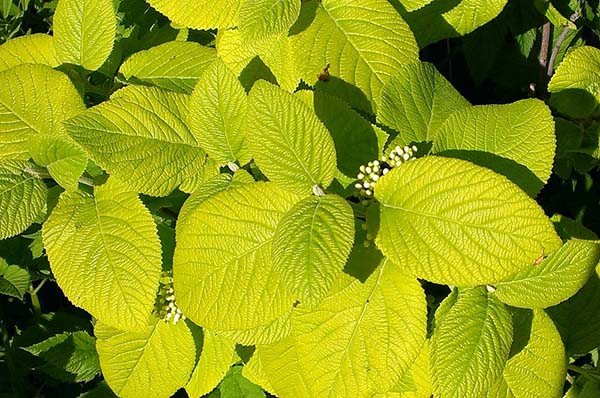
It blooms with flat creamy inflorescences in May. Fruits are red at the beginning of ripening and then turn black.
Note! The fruits are poisonous.
Can be used both in single plantings and in groups (in hedges, flower beds).
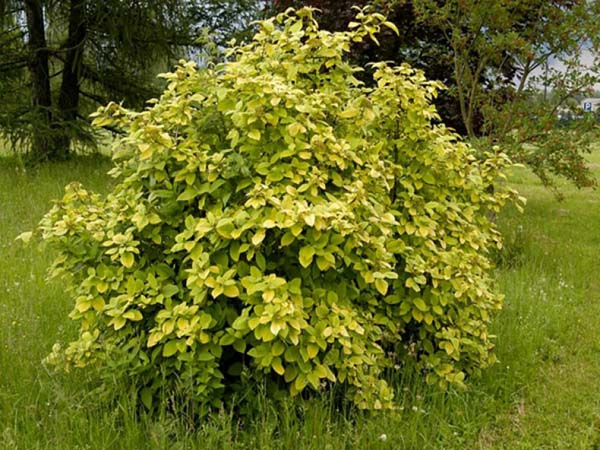
Growing conditions:
- prefers moist fertile soils, almost any acidity (pH 4.5-8.0).
- frost-resistant (up to -35 degrees).
Laurel noble variety "Aurea"
This evergreen shrub, whose height reaches 4-8 meters, and the width is 2.5-5 meters, the leaves acquire a golden yellow hue only in spring.
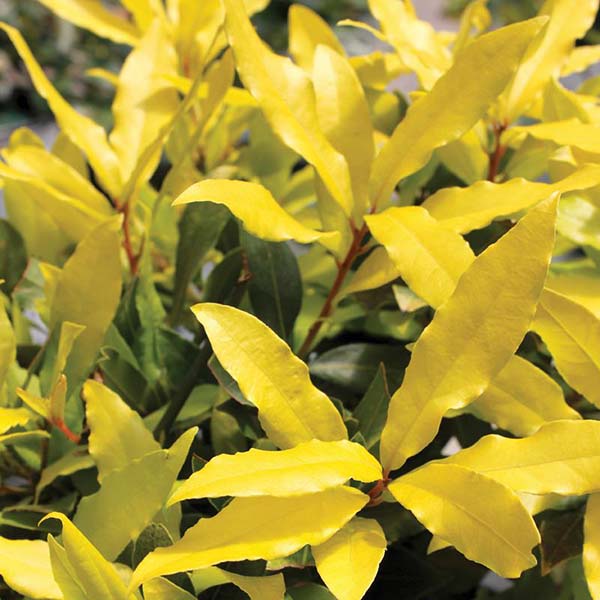 Growing conditions:
Growing conditions:
- drained soil;
- warm climate (withstands a maximum of -5 degrees);
- in cold regions, you can try to grow in a container (put it outside for the summer, keep it at home the rest of the time);
- propagates vegetatively - semi-lignified cuttings.
Japanese spirea
The most popular varieties of Japanese spirea with yellow foliage:
- Golden Carpet;
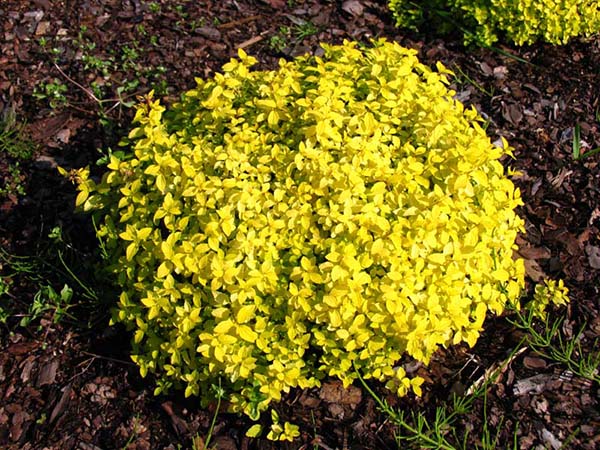
- Golden Princesses;
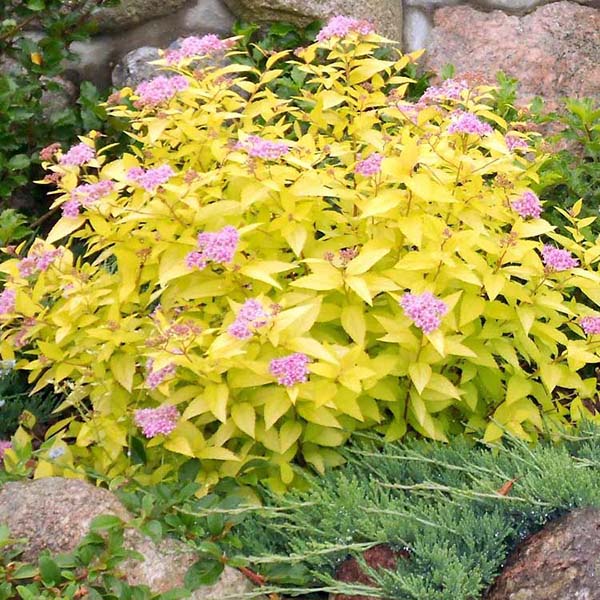
- Goldmound;
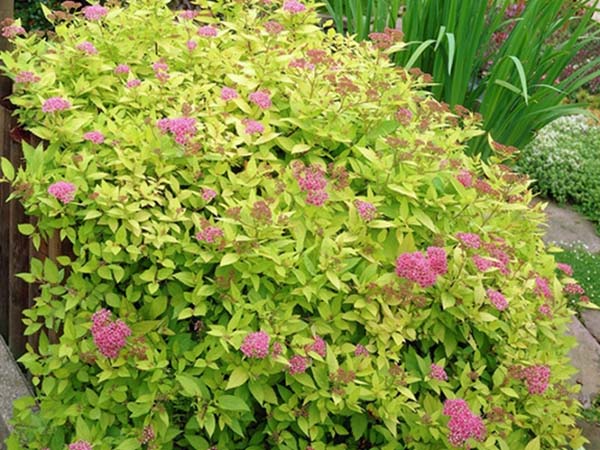
- Goldflame.
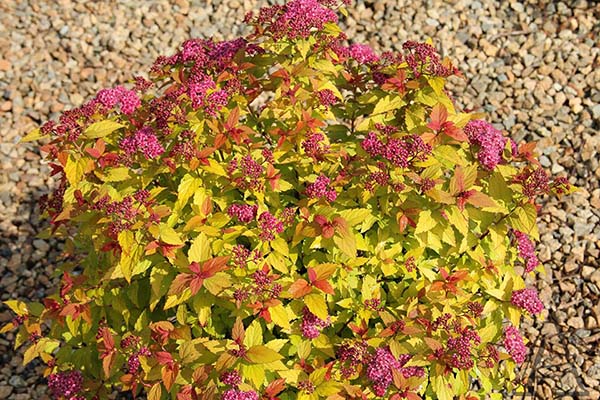
Features of care and cultivation:
- It is not very demanding on the soil, but it will grow better on fertile, drained (loose) soil.
- Sufficient frost resistance (up to -28 degrees).
Chubushnik (Garden Jasmine) crown varieties "Aureus"
This spreading shrub reaches a height of about 2 meters, and its width is 1.5 meters. The ovoid leaves are bright yellow when blooming, but later turn green.
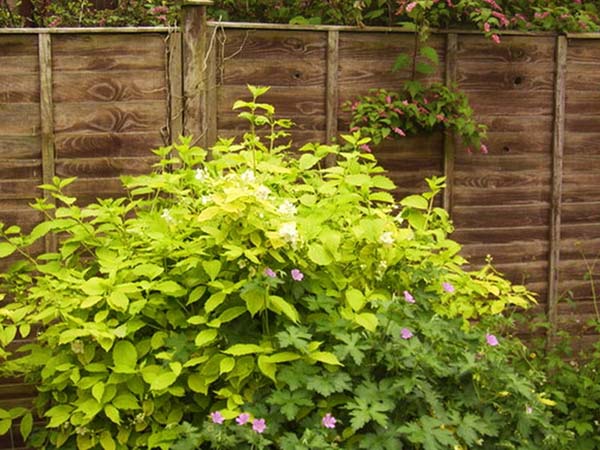
Blooms profusely in May-June with fragrant white flowers.
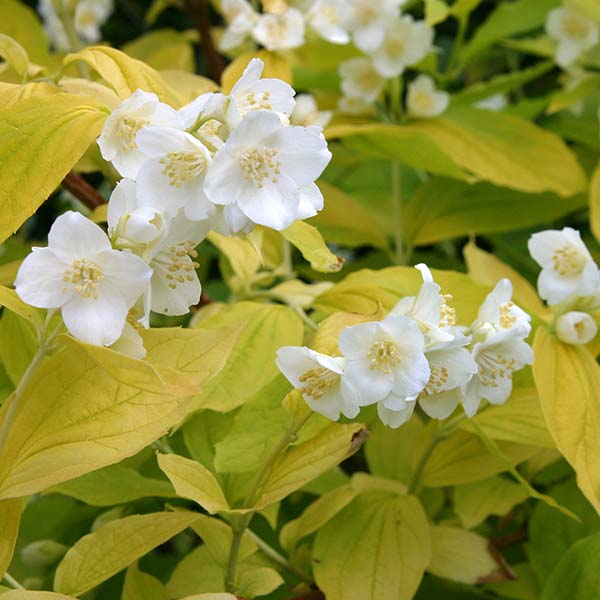
Trees and shrubs (flowers) with yellow flowers
If you want your garden to have trees not only with yellow leaves, but large woody green plants with yellow flowers, then you may be interested in the following:
Anagirolist bean (Golden rain)
A beautiful tree with bright yellow flowers, it is often used both singly and in group planting in personal plots. Flowering time is in April-May. The height of a bean can reach two or more meters.
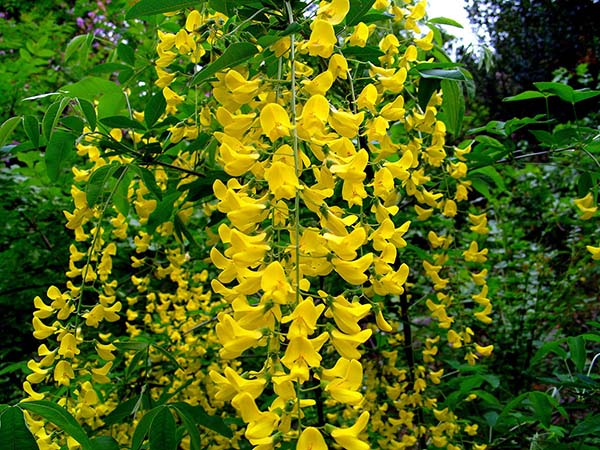
People call it "golden rain" because the inflorescences are similar to the pouring golden drops of rain that can be seen among the bright green foliage.
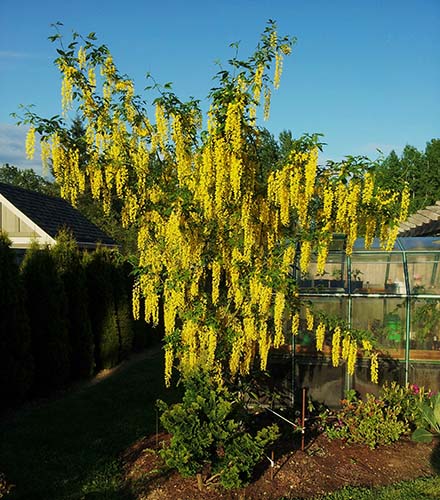
Buddleya David (Butterfly Bush or Ball of Butterflies) varieties "SunGold"
This shrub blooms from the end of summer, and the petals are sunny with a light orange tint. The flower inflorescence resembles lilacs in shape and has an incredibly tasty aroma that attracts a large number of butterflies and bees, which contributed to this name.
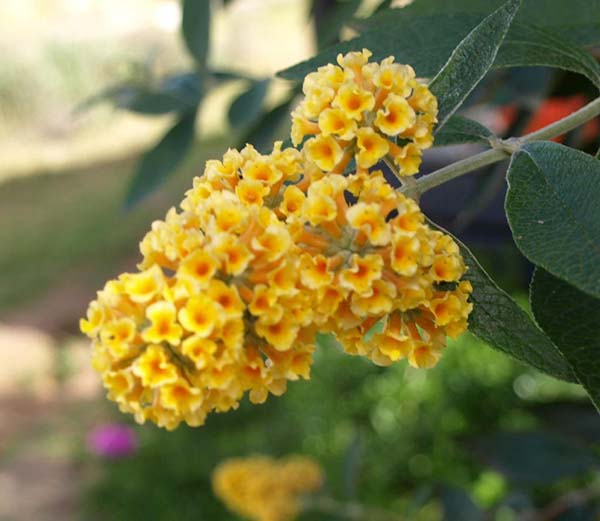
Spring witch hazel (Magic nut, Winter blossom)
A feature of this tree is that it blooms twice a year, namely from April to May, as well as in autumn. The flowers are yellow, rather large, with a pleasant aroma. Under favorable conditions, the tree grows over 2 meters.
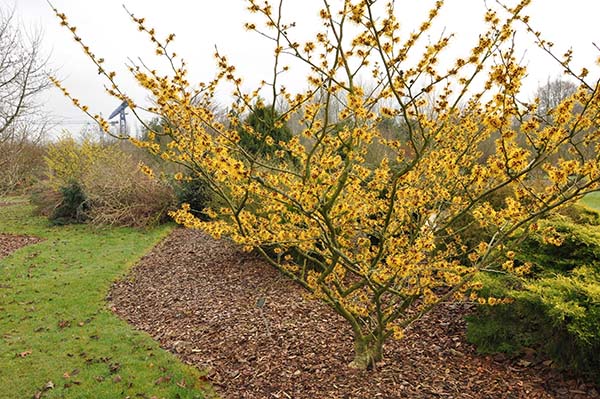
The main advantages of growing witch hazel in the garden are:
- not picky about leaving;
- frost-hardy enough, therefore, does not require shelter for him in winter;
- flowers keep on branches until frost;
- long flowering period.
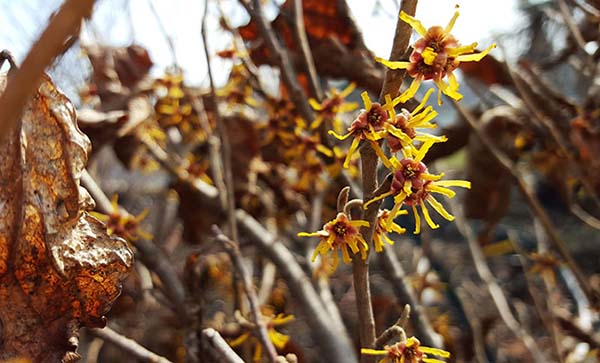
Karagan
There are several varieties:
- Caragana tree (yellow acacia or pea).
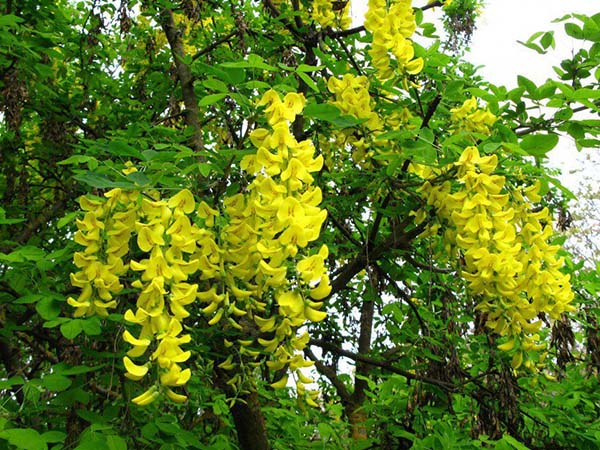
An ornamental shrub (less often a tree) with beautiful yellow fragrant flowers, which are located along branched branches. Height can reach up to 5-7 meters. The flowering period begins in May-June. The shrub is not picky about the soil, it tolerates drought and frost well. A wonderful honey plant. It is recommended to be used as a hedge along the personal plot or as a group composition among green-leaved and other colorful plants. It responds well to a haircut.
- Shrub caragana.
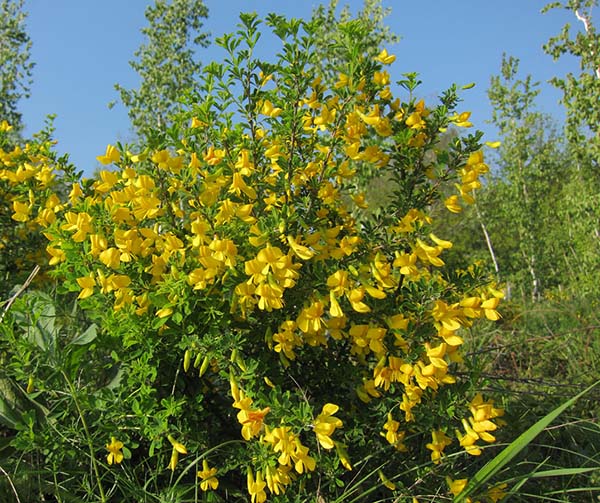
The shrub form has a height of up to 2 meters, otherwise it has similar characteristics and growing requirements.
By the way! If your summer cottage is located on a slope, then Karagana is an ideal shrub that perfectly fixes the slopes.
Rhododendron yellow (Azalea pontus)
This deciduous, yellow flowering shrub plant will be the highlight of the "sunny garden". It can reach a height of 2-4 meters.
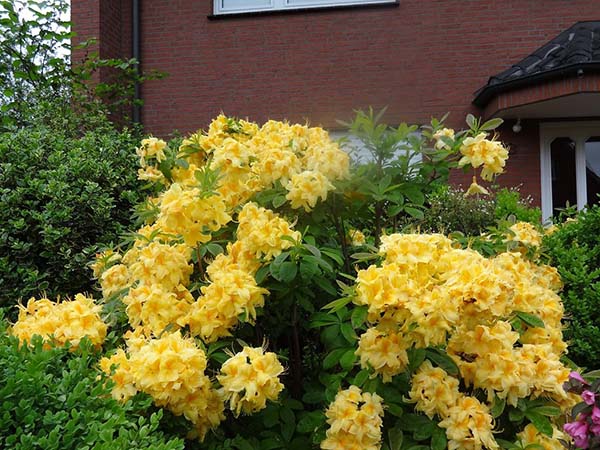
The main advantages of growing this shrub are:
- unpretentious care;
- high frost resistance;
- excellent adaptability in a new place of growth;
- flowering time is 3 months (from April to June);
- has a strong and pleasant aroma;
- in autumn it remains very decorative due to the bright color of the leaves.
By the way! There is also golden rhododendron, but it is practically impossible to grow it under artificial conditions, because the plant suffers greatly due to the high summer temperatures.
Rose yellow
Roses are probably one of the most beloved plants, which is why quite often pink bushes can be found in the garden. Roses with yellow buds are no exception, which will become a decoration among other bright flowers. A brief description of:
- a huge variety of varieties and species;
- the height and size of the bushes directly depends on the variety and type;
- flowers also come in various sizes and shapes;
- can be bush or curly (climbing).
Particular attention should be paid to such a variety of climbing roses as Goldstern and Casino.These climbing shrubs can become a real garden decoration several times in one season.
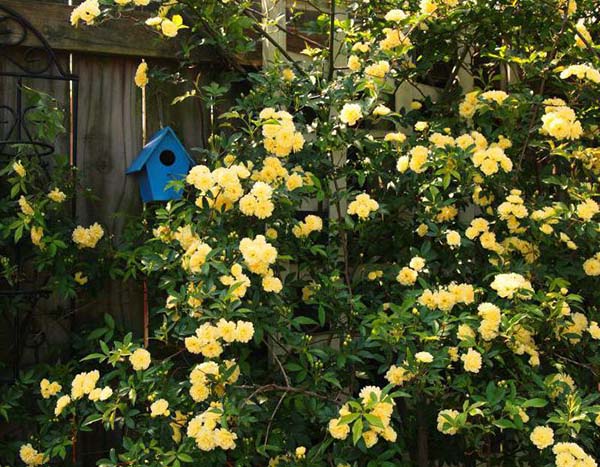
You can also highlight such yellow-flowering varieties:
- Golden Celebration;
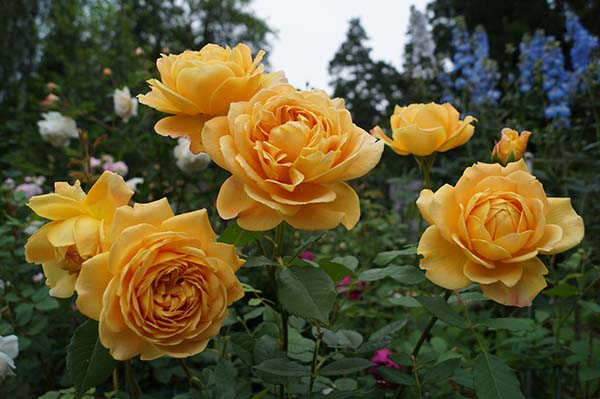
- Crown Princess Margaret;
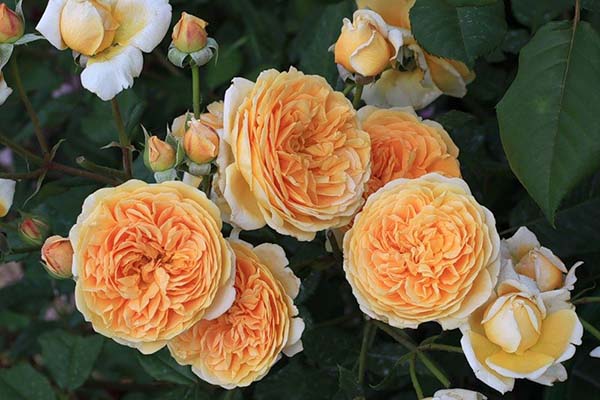
- Berolina;
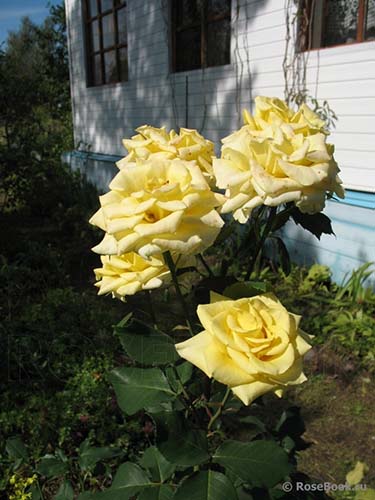
- Gina Lolobrigida.
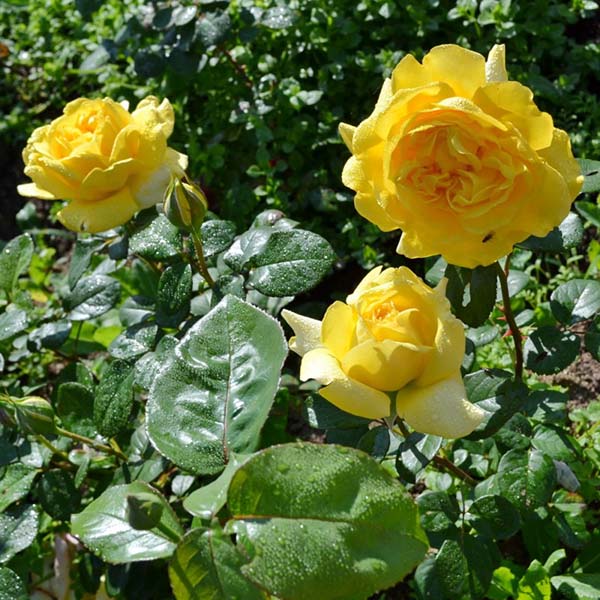
Forsythia (Forsythia)
This is the brightest representative of shrubs, which has a pronounced yellow color of flowers.
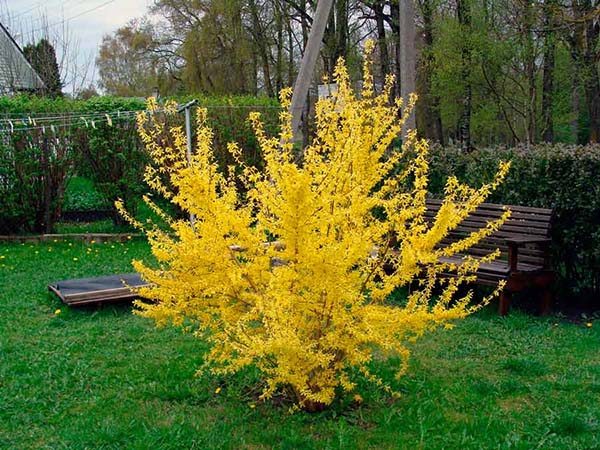
The most popular yellow-flowered forsythia varieties:
- Minigold.
- Linwood Gold.
- Malukh.
By the way! It should be noted that forsythia fell in love with gardeners not only for its bright color, it also blooms almost earlier than all flowering plants (it begins to bloom from mid-April or late May), therefore it will become a true decoration of the garden after the winter season.
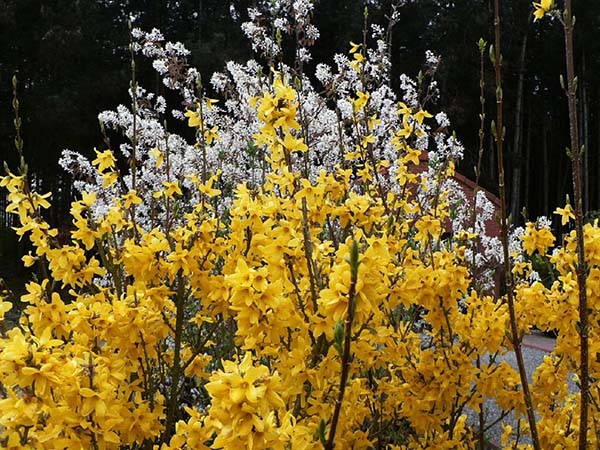
It is worth noting that in nature there are 6 varieties of this shrub:
- Forsythia is greenest (dark green);
- Forsythia is ovoid (oval-leaved);
- Forsythia Giralda;
- Forsythia is European;
- Hanging forsythia (drooping or crying);
- Intermediate forsion (medium).
Growing features:
- fertile (well fertilized) and well-drained soil is required;
- the place must be protected from the wind;
- completely drought-resistant;
- frost-resistant enough (up to -28 degrees).
- easy to propagate by cuttings.
By the way! ABOUT plants with red leaves read in this article.
In conclusion, I would like to say that the use of a variety of colors on a personal plot will become not only an original solution for landscape design, but also an unusually beautiful landscape throughout the year. Trees and shrubs with yellow foliage or flowers fit perfectly into the overall composition, usually represented by green shades in the garden.
Important! When choosing trees or shrubs with yellow foliage, it is imperative to pay attention to the climatic predisposition of the plant, since many of them do not tolerate frosts, which in some climatic zones are very strong.


